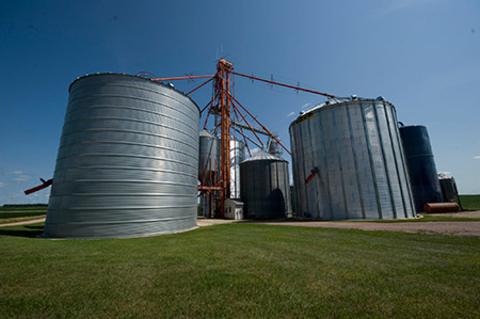Quick facts
- Nearly two dozen people are killed each year in the U.S. in grain entrapment incidents.
- Around 80% of reported engulfments involve a person inside a bin when grain-unloading equipment is running.
- Manage grain spoilage to avoid the most common reason people enter bins.
Risks of working in grain bins
On average, nearly two dozen people are killed each year in the U.S. in grain entrapment incidents. Flowing grain is dangerous, and behaves much like quicksand. In four seconds, a full-grown adult can sink knee-deep from the suction of flowing grain. In just 20 seconds, they can be completely buried.
The pressure of the grain usually hinders self-escape, and can even make assisted escape near impossible. A person buried to the waist in grain requires a force equivalent to their own body weight plus 600 pounds to free them. The force required to remove a person buried under grain can exceed 2,000 pounds.
Flowing grain
Around 80% of reported engulfments involve a person inside a bin when grain-unloading equipment is running. Engulfments in flowing grain can also occur in outdoor storage piles, grain wagons, rail cars and semi-trailers that unload from the bottom.
- As grain is unloaded through the bottom outlet, a funnel-shaped flow develops on the surface of the grain.
- Anyone standing on the surface while grain is being removed from below is at risk of being rapidly pulled down toward the outlet with the flowing grain.
- Submersion takes only seconds and once it begins, the pressure and friction forces of grain on the body are virtually impossible to overcome.
- If grain unloading equipment is not shut off, victims can be pulled down into the unloading conveyor, auger or sump.
Bridged grain
Spoiled grain clumps together and can develop a crust on the top surface. This crust appears solid, but it is unstable and may hide open voids below that develop as grain is removed.
Bridged grain can collapse under a person’s weight, resulting in the victim being buried by falling and shifting grain. If unloading equipment is running at the time this occurs, the victim can be rapidly pulled down toward the bottom of the bin.
Vertical grain wall avalanche
Spoiled grain can form a clumped mass that adheres to the vertical wall of a bin. Entering a bin to dislodge a vertical wall of grain that is higher than the worker is dangerous because the grain wall can suddenly break loose and fall like an avalanche, burying or injuring the victim.
Grain vacuums
When the grain vacuum nozzle is placed below the grain surface, a funnel flow of grain develops. An operator can be pulled into the downward flow of grain if this nozzle is released or becomes buried below the grain surface near the operator’s feet.
Maneuvering the vacuum tube can be awkward, increasing the operator’s risk of slipping or losing balance as he or she tries to reposition the hose in flowing grain. If the operator falls or struggles for position, body movements can trigger an avalanche of grain if the slope of grain is steep.
Safety precautions to prevent grain-related incidents
Manage grain to prevent spoilage
The most common reason people enter bins is to address problems associated with spoiled grain.
To reduce the chance of grain spoilage:
- Maintain aeration equipment in working order.
- Check the structure to identify and fix roof leaks.
- Store grain at the correct moisture content and temperature to prevent grain from spoiling.
Work from outside the bin
- If clumps or crusts develop in the grain, use a pole from outside the bin to probe or knock the clump free.
- Restrict access to bins, storage structures, and outdoor grain storage piles.
- Post signage and lock access doors so unauthorized persons, bystanders and youth cannot enter.
- Post signage at all entry points to bins, outdoor storage piles and other storage structures that warn of the potential for engulfment.
- Require any entry to be done by trained workers following safe procedures.
Create a safe environment on your farm
- Provide training to all employees on the dangers of grain handling and what the safety precautions are.
- Have an emergency rescue plan in place and make sure all employees know what it is and what they need to do if it is put into action.
- Shut down and lock out all grain handling equipment and turn off all power sources when not in use.
Take proper safety precautions if you need to enter the bin
- Always visually inspect the grain bin or storage area before entering it.
- Never enter alone, have at least one other person in a safe position watching you and there to help in case something goes wrong.
- Use fall restraint equipment and make sure it is properly anchored. These systems consist of a full-body harness attached to an anchored line that limits the distance the entrant can drop or fall.
- Most importantly, don’t allow someone who has not been trained to enter a bin with you or with anyone else.
Reviewed in 2020


